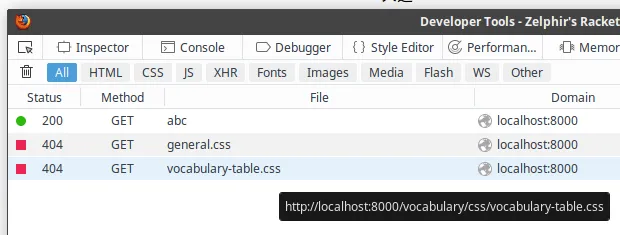我想尝试使用Racket编写一些博客、个人网站或本地网络服务。我已经完成了这里的教程,然后我发现了这篇邮件列表条目。除此之外,我还使用了文档中的信息。基于URL的调度似乎比教程更容易,所以我选择了这种方式,并得到了以下代码:
#lang racket
(provide/contract
(start (-> request? response?)))
(require
web-server/templates
web-server/servlet-env
web-server/servlet
web-server/dispatch)
;; =====
;; STATE
;; =====
(define (get-vocabulary-for-topic topic)
;; for now always returns the same
(list
(list "sich fuer eine Person entscheiden" "xuǎnzé" "32" "选择")
(list "teilnehmen" "cānyù" "14" "参与")
(list "die Wahl" "dàxuǎn" "43" "大选")))
;; ======================
;; APPS HANDLING REQUESTS
;; ======================
(define (vocabulary-app request topic)
(response/full
200 #"OK"
(current-seconds) TEXT/HTML-MIME-TYPE
empty
(list (string->bytes/utf-8 (render-vocabulary-page topic)))))
(define (vocabulary-overview-app request)
(response/xexpr
`(html
(head (title "Vocabulary Overview")
(link ((rel "stylesheet") (href "css/general.css") (type "text/css"))))
(body (p "This is an overview of vocabulary pages.")))))
(define (overview-app request)
(response/full
200 #"OK"
(current-seconds) TEXT/HTML-MIME-TYPE
empty
(list (string->bytes/utf-8 (render-overview-page)))))
;; ===============
;; RENDERING STUFF
;; ===============
(define (render-vocabulary-page topic)
(let
([vocabulary (get-vocabulary-for-topic topic)])
(let
([content (render-vocabulary-table vocabulary)]
[page-title "Vocabulary"]
[special-css-imports
(render-css-include "css/vocabulary-table.css")]
[special-js-imports ""]
[header ""]
[footer ""]
[navigation ""])
(include-template
"templates/base.html"))))
(define (render-vocabulary-table vocabulary)
(let
([table-headers (list "German" "Pinyin" "Tones" "Chinese")]
[word-list vocabulary])
(include-template "templates/vocabulary-table.html")))
(define (render-overview-page)
(let
([content
(let
([subpage-titles (list "vocabulary")])
(include-template "templates/overview.html"))]
[page-title "Overview"]
[special-css-imports ""]
[special-js-imports ""]
[header ""]
[footer ""]
[navigation ""])
(include-template
"templates/base.html")))
(define (render-css-include path)
(let
([path path])
(include-template "templates/css-link.html")))
;; ====================
;; ROUTES MANAGING CODE
;; ====================
(define (start request)
;; for now only calling the dispatch
;; we could put some action here, which shall happen before dispatch
(blog-dispatch request))
(define-values (blog-dispatch blug-url)
(dispatch-rules
[("index") overview-app]
[("vocabulary") vocabulary-overview-app]
[("vocabulary" (string-arg)) vocabulary-app]))
(define (respond-unknown-file req)
(let
([content (include-template "templates/unknown-file.html")]
[page-title "unknown file"]
[special-css-imports ""]
[special-js-imports ""]
[header ""]
[footer ""]
[navigation ""])
(response/full
404 #"ERROR"
(current-seconds) TEXT/HTML-MIME-TYPE
empty
(list
(string->bytes/utf-8
(include-template "templates/base.html"))))))
;; ===========================
;; ADDED FOR RUNNING A SERVLET
;; ===========================
(serve/servlet
start
#:servlet-path "/index" ; default URL
#:extra-files-paths (list (build-path (current-directory) "static")) ; directory for static files
#:port 8000 ; the port on which the servlet is running
#:servlet-regexp #rx""
#:launch-browser? true ; should racket show the servlet running in a browser upon startup?
;; #:quit? false ; ???
#:listen-ip false ; the server will listen on ALL available IP addresses, not only on one specified
#:server-root-path (current-directory)
#:file-not-found-responder respond-unknown-file)
到目前为止,这很好运作,除了在我导航到任何“子页面”时,我的静态目录中的任何文件,实际上是在“静态”目录的子目录中,即“css”无法找到。
我的意思是,“主页”将是像
localhost:8000/index或localhost:8000/vocabulary这样的东西,而子页面将是像localhost:8000/vocabulary/something这样的页面。似乎模板渲染出了问题,没有始终从应用程序目录的根目录访问静态目录,而是只查看
localhost:8000/vocabulary/css/general.css,而当我转到任何“主要页面”时,它应该查看localhost:8000/css/general.css。这里是一个主页的截图:
而这是在子页面上的:
所以静态目录似乎会根据访问的URL而改变。起初,我以为自己终于明白了如何提供静态文件,但似乎并没有,我不知道如何以最好的方式解决这个问题。
这是我的目录结构:
/home/xiaolong/development/Racket/blog2
- static/
- css/
general.css
vocabulary-table.css
+ img/
+ js/
- templates/
base.html
css-link.html
js-link.html
overview.html
unknown-file.html
vocabulary-table.html
blog-demo.rkt
blog.rkt
我该如何修复静态文件路径?
我希望能够在代码中简单地键入css/something.css,而无论是哪个应用程序或路由,它都应该提供文件,并且我不想根据我正在处理的代码路由更改包含路径。
我用于运行服务器的命令很简单:
racket blog.rkt
从项目的根目录开始。

